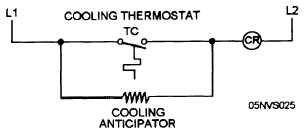The manufacturing engineers determine what type and design of thermostat should be installed in a particular system. Knowing and understanding the advantages and disadvantages of different types of thermostats will help you identify the type of thermostat being used in a system and enable you to troubleshoot an inoperative system efficiently.
Electrical room thermostats are in three categories: line voltage, low voltage, and millivoltage. Line-voltage thermostats are usually 115 volts. When line - voltage thermostats are installed, there is no need for lowering voltage with a transformer. However, line-voltage thermostats are dangerous for the users and the cost is higher. Normally line-voltage thermostats are located only in industrial commercial applications.
Low-voltage thermostats (24 volts) are not dangerous to the user. They are also more cost efficient than line-voltage models. The disadvantage of low-voltage thermostats is the extra requirements of wiring and additional components; they are less rugged than line- voltage thermostats.
The millivoltage thermostat operates at 750, 500, or 250 millivolts. This thermostat uses its own power source for operation and is not affected by power interruptions. The system requires only a small amount of wiring compared to other systems. However, this system is limited for use only in heating applications. The temperature control is less precise than other systems, wire length and size are critical, and the system requires a separate device to power a 24-volt control, or you must use a millivoltage control.
Anticipators
One component that enhances the operation of a thermostat is an anticipator. Anticipators are of two types-heating and cooling. The heating anticipator produces false heat in a thermostat to prevent extreme temperature changes within a space. The false heat created by resistance increases the thermostat rate of response. Basically, the thermostat receives false heat which shuts down the heating source before the thermostat reaches the desired temperature. This action reduces overshooting and is economically efficient. The heating source shuts off and the blower continues to run using the heat transferred from the surface of the furnace and ductwork. When adjusting a heating anticipator, you must set the anticipator resistance to match the current rating of the primary control.
The cooling anticipator adds false heat to the thermostat bimetal element the same way as a heating anticipator. Unlike the heating anticipator, cooling anticipators are not adjustable; they are sized by the manufacturer of the thermostat. The cooling anticipator is placed in parallel with the cooling contacts. By studying figure 14-20(D), you can see that the cooling anticipator is energized when the unit is in the OFF cycle (thermostat contacts open). The small amount of heat produced by the resistance heat closes the TC before the actual temperature in the space reaches the thermostat cut-in setting. This action allows the unit to start removing heat before the temperature in the space climbs above the desired temperature. When the cooling

Figure 14-20(D). - Cooling anticipator.
Continue Reading